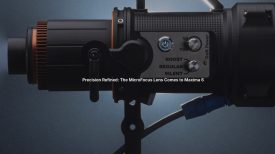By site editor Dan Chung:
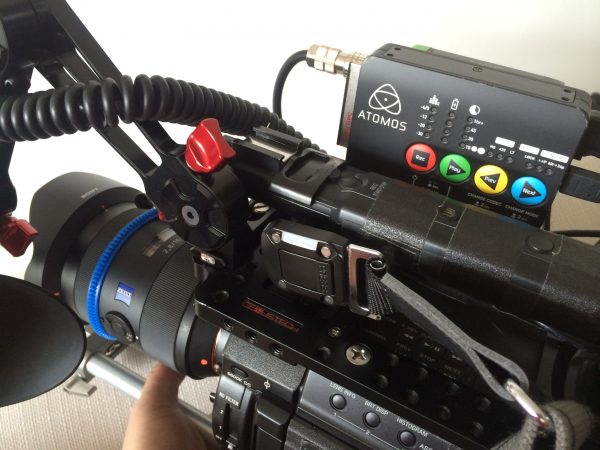
I’ve been using a pre-production version of the tiny Ninja Star Prores recorder for several weeks now. They are beginning to ship to dealers this week so I thought I would share my impressions:
About the size of a pack of cards and weighing a mere 130g it is the latest in the line of ProRes capable recorders from Atomos. The small form factor adds very little weight and bulk to a camera and this is especially useful for handheld work. It is essentially the recorder part of the full size Ninja, but without the screen.
It can record a HDMI signal in 1080 HD in Prores HQ, 422 or LT. The HDMI input is micro sized and you will need the appropriate cable for your camera. These should be available from any good electronics store but Atomos are also selling their own versions which are coiled for extra safety. There is also a micro HDMI loop through output for monitoring if needed. A minijack audio input is available for cameras that don’t pass audio over HDMI, like the Canon 5D mkIII. A LED meter allows you to keep an eye on audio levels (although unlike the Ninja Blade there is no way to adjust these on the recorder itself – only on the camera).
Four buttons are the only controls on the recorder. These are brightly painted in the now familiar Atomos colours. They are Record, Playback, Previous and Next clip. This is pretty self explanatory and the buttons themselves have a nice, positive feel about them. Each button also has a secondary function. Holding down the Rec button when the device is off powers it on. Holding the Rec and Play buttons simultaneously for three seconds formats the CFast card. Holding the Prev button down for two seconds cycles through the Prores flavours and holding the Next button changes the pulldown conversion.
Unlike other Atomos recorders, which use SSD drives, the Ninja Star records to CFast cards. Not to be confused with Compact Flash cards, CFast cards are similar in size but are built with reliability in mind. Other cameras to use CFast include the Arri Amira and soon the Blackmagic Design URSA. I have been testing the recorder with an expensive Sandisk 64Gb CFast 2.0 card but it turns out that the Ninja Star can also use cheaper generation one CFast cards. Indeed Atomos have recently announced that they will sell their own branded generation one CFast cards at a competitive $160 for 64GB. CFast cards also need their own card reader, luckily Atomos are going to include one of these in the box and additional ones may be ordered if needed. While CFast cards are more expensive the CF cards I can see why Atomos have gone this route. Even now only faster CF cards support Prores HQ recording on other recorders such as the AJA KiPro Mini, and over time reliability can become an issue. I would rather pay a slightly higher price and have greater confidence about the reliability of recording.
CineGear – Atomos Ninja Star and Cheap CFast Cards & Reader from Nate Weber on Vimeo.
A 64Gb CFast card gave approximately an hour of ProRes 422. I think two or three of these cards should prove enough for most shooters to shoot for a day. Downloading times to computer via USB3.0 were impressively quick so offloads are easy. The cards feel solid and I’m guessing they will stand daily use better than SD or CF.
A small cheese block can be mount on the Ninja Star, which it turn can be attached via a hotshot adapter, Noga arm or quick release plate to your camera package. However I found that the recorder was light enough to be attached simply by using Rescue tape to my Canon C100 top handle. The finished setup feels very tight and good in the hand.
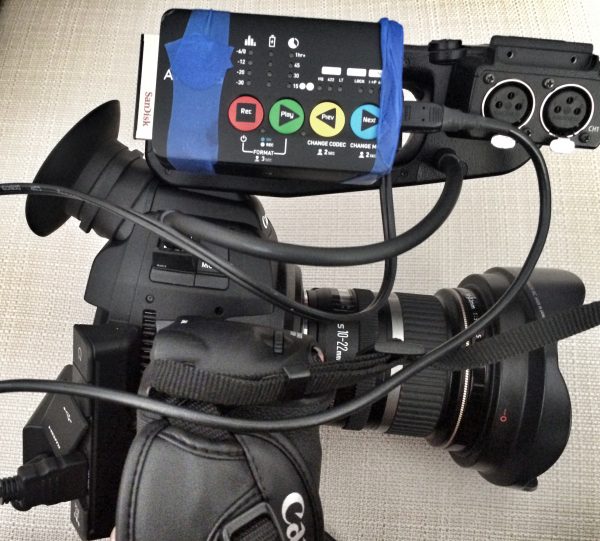
Not only is my C100 setup lovely and small, the C100 is one of several camera that can actually start and stop recording on the Ninja Star at the same time as the in camera recording. The camera can send start and stop protocols via the HDMI which the recorder recognises. Other cameras without this protocol can still be used but the recorder will have to be triggered manually using the large buttons on it’s facia. When recording small red light flashes to tell you all is well. There is also a series of LEDs that show approximately how much recording time you have left and the status of the battery.
For power the Ninja Star uses a Sony L type battery which should last several hours. Atomos also make a DC power adapter that has a P-tap connection on it. This was designed so you could power the recorder from larger V-lock or Anton Bauer batteries. Luckily a better solution exists for my C100 setup. Swit make the S-8845 a replacement Canon BP series battery that runs the camera but also has a small dc power output for a barrel connector (there is a similar Swit battery for Sony cameras with L size batteries). With the correct P-tap to barrel connector cable you can run the Ninja Star from the same battery at the same time. Genius!
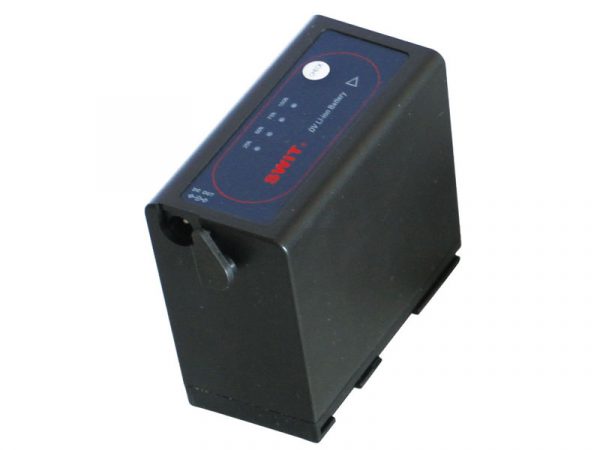
The build quality is good. Even thought the unit is small it feels solid. I do remain sceptical about the durability in general of micro HDMI connections and care should be taken to avoid damage both on the camera and recorder ends. Full sized HDMI connectors are already weak compared to a good BNC connection, the micro HDMIs are even worse. On my C300 setup I managed to mount the Ninja Star in such a way that the HDMI has at least some protection from being knocked. I think there is room for an after market HDMI port protector for the Ninja Star – for now I may just fashion something out of Sugru.
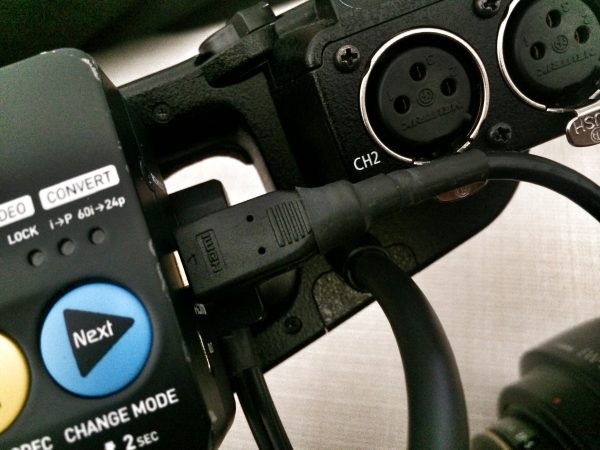
I do wish there was a HD SDI version of the Ninja Star as well. This would make it even more appealing for use with higher end cameras and also older broadcast cameras without HDMI. You can add an Atomos Connect convertor to the Ninja Star to get this functionality – but this adds extra cabling and weight.
One other concern I did have was about how weather proof the Ninja Star is. I would worry about water getting into the card slot in wet conditions. Luckily the Ninja Star is so small it can comfortably fit under the rain cover I have for the C300.
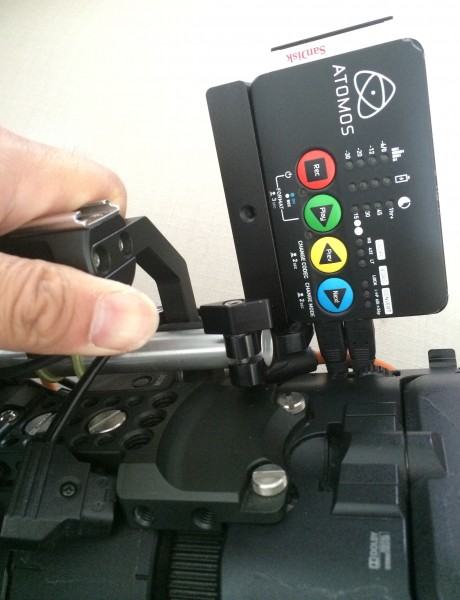
The best part about the Ninja Star is it’s size. For news and documentary shooting I think it is almost perfect. The recorder can be used with many different cameras and even doubles as a tiny portable playback device. It is also a simple way to give a lease of life to older handheld cameras, like the Sony FS100, loosing the bulk typically associated with external recorders. Another use is as a way to record HD output from the Panasonic GH4 while shooting 4K internally at 24P (sadly it doesn’t work with 25P yet and I suspect this is a Panasonic issue). Other uses include aerial work on quadcopters, with GoPros, on brushless gimbals and Steadicams.
In short I recommend it and have added one permanently to my C100 kit bag.
Full disclosure: The pre-production Ninja Star was lent to Newsshooter by Atomos for evaluation. It was not a full production version and some specs may have changed. Atomos is a sponsor of this site.



